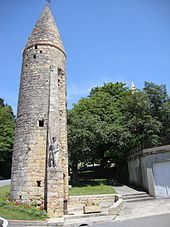Avignonet-Lauragais
|
Avignonet-Lauragais Avinhonet de Lauragués |
||
|---|---|---|

|
|
|
| region | Occitania | |
| Department | Haute-Garonne | |
| Arrondissement | Toulouse | |
| Canton | Revel | |
| Community association | Terres du Lauragais | |
| Coordinates | 43 ° 22 ′ N , 1 ° 47 ′ E | |
| height | 176-274 m | |
| surface | 40.66 km 2 | |
| Residents | 1,534 (January 1, 2017) | |
| Population density | 38 inhabitants / km 2 | |
| Post Code | 31290 | |
| INSEE code | 31037 | |
 Notre-Dame-des-Miracles church |
||
Avignonet-Lauragais ( Occitan : Avinhonet de Lauragués ) is a place and a French municipality ( commune ) with 1,534 inhabitants (as of January 1, 2017) in the Haute-Garonne department in the Occitania region (until 2015 Midi-Pyrénées ).
location
The place is on a hill at a height of about 200 meters above sea level. d. M. in the old cultural landscape of the Lauragais , about 44 kilometers (driving distance) in a southeast direction from Toulouse . Another 17 kilometers to the southwest is Castelnaudary . All of the cities mentioned are located on the Canal du Midi and are connected to each other via the A61 autoroute and the Toulouse – Narbonne railway line.
history
In medieval times, Avignonet-Lauragais was a variant of the pilgrimage route to Santiago de Compostela ( Via Tolosana ). The place became famous through an event in 1242: The inquisitors of Toulouse, Guillaume Arnaud and Étienne de Saint-Thibéry , and the servants were through during the night of a group of Albigensians under the leadership of Pierre Roger II. De Mirepoix Ax blows killed. Part of the population of Avignonet sided with the attackers, who managed to escape and retired a year later to Montségur Castle , where most of them were killed at the stake during its siege and conquest (1244) .
In the course of the Hundred Years War (1337-1453) between England and France, the fortifications of Avignonet were razed by the troops of the Black Prince ( Edward of Woodstock ) in 1355.
Population development
| year | 1962 | 1968 | 1975 | 1982 | 1990 | 1999 | 2006 | 2012 |
| Residents | 1,117 | 1,040 | 938 | 931 | 954 | 1,069 | 1,220 | 1,399 |
In the 19th century, the place had over 2,400 inhabitants at times. Since around 1870, there has been a clear decline in population, which has intensified in the 20th century due to the mechanization of agriculture and the associated loss of jobs.
economy
In earlier times, the residents lived largely as self-sufficient on the income from the fields and livestock. In the late Middle Ages and early modern times, woad ( pasteel ) was grown almost exclusively in the entire region of the Lauragais ; the branch of industry took place in the 17th / 18th Century ended with the import of indigo. The population growth over the past few decades is an indicator of the city's economic development. Due to the proximity to the city of Toulouse and lower land prices, an industrial zone was designated in the outskirts of the town. In the years after 2000, several wind and solar parks were set up in the Avignonet area.
Attractions
See also: List of Monuments historiques in Avignonet-Lauragais
- The construction of the Notre-Dame des Miracles church began in 1385. It is a building in the style of the Tolosan brick Gothic . The west tower, which is square in the lower part but octagonal at the top, is unusual - such towers are usually only found in the area around Toulouse as crossing towers or at the side of the church; the west facade was mostly without a tower or ended in a bell gable (cf. Villefranche-de-Lauragais ). Northern French influences must have played a role here, as the former county of Toulouse fell to the French crown domain ( domaine royal ) in 1271 . The interior of the single-nave church is spanned by a rib vault; the nave is accompanied by side chapels. The church has been recognized as a monument historique since 1926 .
- As in the neighboring town of Villefranche-de-Lauragais, almost nothing of the former city wall has survived in Avignonet - only the so-called Powder Tower ( Tour poivrière ) or Tour de la Porte de Cers from the 14th century, which has been around since that year 1965 is also recognized as a Monument historique .
- In the vicinity of the small town there are still some long-disused and mostly disintegrated windmills.
Partner communities
literature
- Le Patrimoine des Communes de la Haute-Garonne. Flohic Editions, Volume 2, Paris 2000, ISBN 2-84234-081-7 , pp. 1695-1700.
Web links
Individual evidence
- ↑ Église Notre-Dame-des-Miracles, Avignonet-Lauragais in the Base Mérimée of the French Ministry of Culture (French)
- ↑ Tour, Avignonet-Lauragais in the Base Mérimée of the French Ministry of Culture (French)

